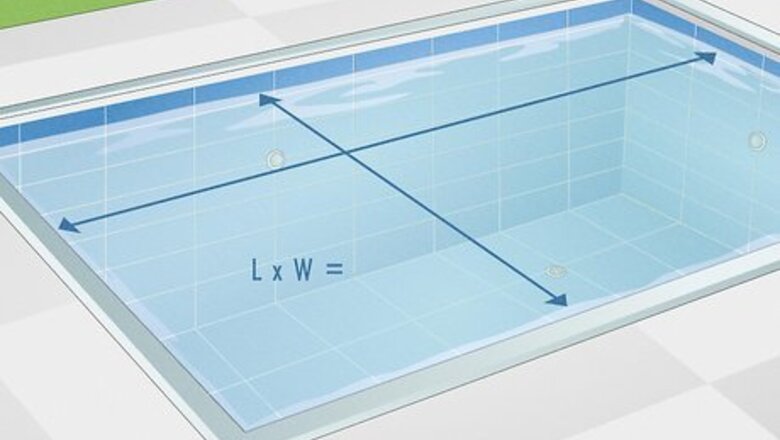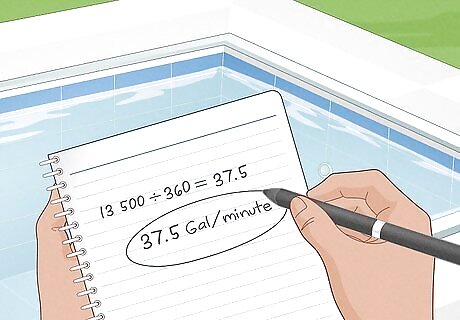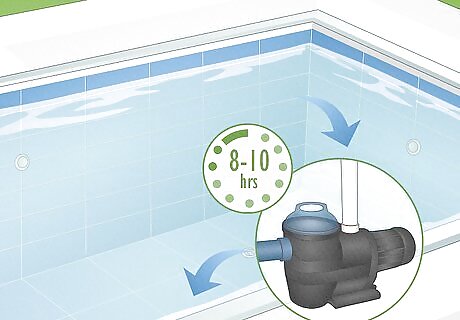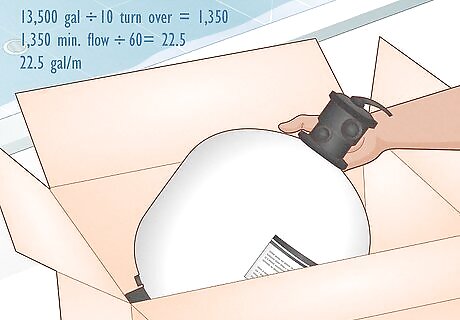
views

Find the surface area and the volume of water your pool can hold. Pools come in all types of shapes. However, there are two common kinds: rectangular and round. Depending on the one you’ve purchased, make sure you’ve correctly calculated its size with the right mathematical formula. Rectangular pools are by far the most simple to measure. Simply multiply its length with the width. Surface area = L x W If you opt for a round pool, perhaps a hot tub or a smaller children’s pool, the calculation involves taking the radius of the circle, raising it to the power of two, then multiplying the product with 3.14. Surface area = 3.14 x r Measuring your pool’s surface area yourself works well, but if you just bought your pool, then measurements should be provided upon purchase.

Find the pool’s maximum volume of water. Then, use your pool’s volume to find out how much water can move through your filter in about a minute. This is called ‘’flow rate’’. The flow rate differs from the kind of pool you have. Ensure you calculate with this in mind to get the most out of the eventual filter you will use. To find your pool’s volume, take the maximum volume of water your pool can hold (this amount can be found upon purchasing of your pool) and divide it by 360. This will tell you how many gallons of water that goes through your filter in a minute. It’s best to get a filter that is slightly oversized for your pool to ensure maximum efficiency. If the flow rate for the filter is too much and the operation pressures for the filter are too high you can increase the pipe size of your plumbing system, in part or in whole, and this will reduce the operational pressure of your system. All filters have a minimum and maximum flow rate that the pump must fall within. Too weak or too much flow and the filter will not operate correctly. Make sure the filter you get is able to accommodate for the amount of water in your pool.

Establish your pool’s turnover rate. This means knowing how long it takes for the water to completely cycle through the filter. Most municipal health codes require a minimum filtration turnover rate of two complete turnovers of the water in a 24 hour period. The minimum turnover rate is one that turns over the entire pool once in 12 hours. A turnover rate of 8 or 10 hours is the typical sizing rates for pools today. If the pool is for commercial, semi commercial or high bather turnover applications then you will want to choose a filter that will allow you to turn over the entire volume of water at least four times every 24 hour period.

Choose the right filter. The correct filter size depends on the size of the pool. To maintain good water clarity you must run the pump each day so that all the water in the pool is turned over. All filters have gallon per minute design rating and turnover rate. For example: A 24 feet (7.3 m) round above ground pool has approx 13,500 gallons (51,103.1 L). A Hayward S166T Sand Filter has a 10hr turnover rate of 18,000 gallons (68,137.4 L) and would work well with this pool.

Consider how much water resistance there will be that can affect your pool’s turnover rate. The faster water moves through the pump, the more resistance you’ll have. Choose a filter that would at a minimum turn your pool over in 10hrs. With filters it is okay to go bigger.. Larger filter areas will help to maintain good water clarity. Remember that the faster the velocity of water moving through the plumbing system, the more resistance to flow the water has. This means a slower pump like low speed on a 2-speed pump has a flow increase per unit of power on lower speeds versus the high-speed option. Note that most 2 speed pumps set to low speed will not meet the minimum flow requirements for the filter to function properly.

Take all the information gathered about your pool to find a suitable filter size. By using a simple equation you should have no problems. Before putting it all together make sure you’ve correctly calculated the pool’s volume (in gallons) and decided on a reasonable turnover rate for all the water to be cycled through the filter. The equation used in calculating filter sizes is: Pool capacity in gallons divided by the desired turnover rate in hours. This will give you the minimum flow needed in gal/h (Gallons per hour). Divide this number by 60 to get the gal/min. Find a pump that meets the gal/m you just calculated.



















Comments
0 comment